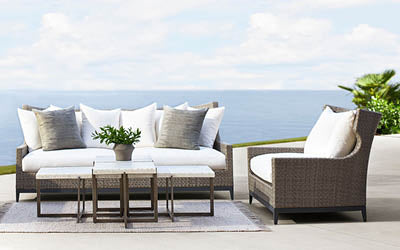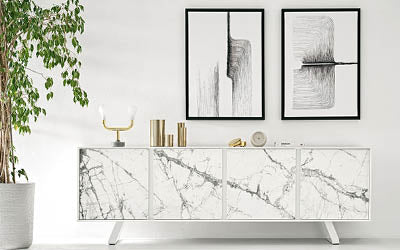RENEWAL ON FIFTH
A connoisseur of antique rugs chose a streamlined, transitional décor to complement his collection.

A mansion-size antique Persian rug in muted blue and gold tones provides the decorative foundation for this updated living room overlooking New York’s Fifth Avenue. The pared-down moldings and built-in cabinets are new. In fact, the only element left untouched in the gut renovation was the fireplace surround.
Prewar apartments in so-called "good buildings" on Manhattan’s Upper East Side are prized by buyers, but they rarely come in move-in condition. The apartment you see here harbored a riot of styles, says interior designer Lorraine Gordon, complete with mid-20th century plywood cabinets and flower power wallpaper from the 1970s. “The only real choice was to gut the space and start over."
Her client is a collector of antique Persian rugs, most of which predate the building by decades or even a century. But they’re the kind of rugs that play well in a contemporary setting, and that’s what the collector wanted—a fresh look that could be described as both elegant and up to date.
Virtually every surface was, well, resurfaced. Except for a carved fire surround and traditional radiator covers, the millwork was replaced with pared-down transitional moldings. Custom display cabinets flanking the fireplace are almost devoid of ornamentation.

The coffee table is topped with a simple Carrara marble slab in the living room where designer Lorraine Gordon chose a subtle, hand-painted wallpaper to accent one long wall.
A mansion-size carpet in muted blue and gold tones provides the decorative foundation for the living room. To complement the antique, Gordon selected a subtle, hand-painted wallpaper and applied it to a single long wall. Large-scale upholstered pieces—sofas, wing chairs and a club chair—are free of pattern so as not to compete.
The designer played out a similar scheme in the media room, where a deep blue antique rug takes pride of place. All other pattern is banished. The walls are muted, as are the fabrics, both dark and light, on the sofa and chairs. A monumental photograph of a horse lends a bold, graphic touch. Virtually monochromatic, the portrait does not detract from the grandeur of the Persian rug.

In the dining room, the rug is contemporary, and so is the furniture. Graceful chairs with sloping backrests and tapering, out-curved legs are an update of the ancient klismos style. The credenza is topped with a simple Carrara marble slab.
The dining room tells its own story. Here the rug is contemporary, and so is the furniture. Graceful dining chairs, an update of the ancient klismos style, have sloping backrests and tapering, out-curved legs. A long, lacquered credenza is topped by a simple Carrara marble slab. Above it hangs a large abstract painting, bolder and more brooding than the art in the other rooms.

An antique Persian rug takes pride of place in the media room, above. The large portrait of a horse, while graphically bold, is soft enough in color that it does not detract from the rug.
In keeping with the transitional aesthetic—and the goal of letting the fine handmade rugs shine—Gordon was ever-so-slightly spare with furnishings. That’s especially true in the grand-scaled entrance hall, where a console topped with lamps and a mirror suffice to define the gallery-like space. This elegant apartment is less about what’s on the walls than what’s on the floors.

In the grand-scaled entrance hall, a console topped with lamps and a mirror suffice to define the long, gallery-like space.










